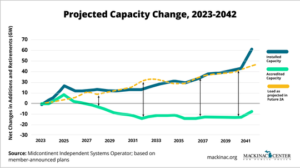Fossil fuel closures will hollow out the grid
Utilities and state governments are pushing full steam ahead with decarbonization plans that will lead to costlier energy and power blackouts. The nation’s electricity grid operators, regulators, and reliability watchdogs alike testify that closing fossil fuel and nuclear electricity generation poses an imminent threat to the reliability of the power grid.
“The problem is the subtraction of dispatchable resources such as coal and gas,” Federal Energy Regulatory Commissioner Mark Christie said during testimony to Congress last year. “The core of the problem is actually very simple. We are retiring dispatchable [quickly controllable] generating resources [coal and natural gas] at a pace and in an amount that is far too fast and far too great and is threatening our ability to keep the lights on.”
Christie warned that “the United States is heading for a very catastrophic situation in terms of reliability,” and he is far from alone in his assessment.
“When you do the math — when you look at the rate of retirements, you look at the rate of growth, and you add in the current rate of throughput for our queue — we are headed for some trouble. And that trouble is likely to find us later in the decade,” Manu Asthana, CEO of PJM, the grid operator for parts of the eastern United States, told the Electric Power Supply Association during his keynote speech at their Competitive Power Summit last year.
“[I]t is not possible to run an electric system — a reliable electric system — on just wind, solar, and storage,” testified a representative of New York ISO, the grid operator for the Empire State, to the House Subcommittee on Energy, Climate, and Grid Security.
In the same hearing, a PJM representative stated that “one megawatt of wind, solar or battery isn’t enough to replace one megawatt of dispatchable thermal [fossil fuels and nuclear] generation. It takes many megawatts, and usually a range of technologies available at different times, to effectively replace a megawatt of thermal generation.”
Utilities appear to be adding enough gigawatts of wind and solar, but these sources suffer from fundamental intermittency flaws.
“A megawatt of nameplate wind and solar is not equal to a megawatt of nameplate coal or gas. It’s just reality,” explained FERC Commissioner James Danly. “[If] you lose eight gigs of dispatchable, and you pick up 24 gigs of wind and solar, [you may think] you’re fine right now. You’re not fine.”
“The reliability of the BPS [Bulk Power System, effectively synonymous with the electric grid] depends on the operating characteristics of the replacement resources,” reports the North American Electric Reliability Corporation. “Merely having available generation capacity does not equate to having the necessary reliability services or ramping capability to balance generation [supply] and load [demand]. It is essential for the BPS to have resources not only with the capability to respond to frequency and voltage changes, but to actively provide those services.”
The problem highlighted by all these experts comes from the important difference between “nameplate capacity” and “accredited capacity.” Both terms describe a given power plant’s production capabilities. Nameplate (or installed) capacity is the ideal amount of electricity that could be generated given perfect conditions, while accredited capacity is what a generator provides in reality.
“Capacity factor” is the relevant measurement, showing the percentage of the nameplate capacity that a power plant actually generates. The average capacity factor of wind over the last decade hovered around 35%, according to data from the U.S. Energy Information Administration. For solar, it was about 25%. Meanwhile, natural gas combined cycle plants sat around 55%, coal was around 50%, and nuclear had a 93% capacity factor.
“A nameplate megawatt of wind or solar is simply not equal in terms of capacity value to a nameplate megawatt of coal or gas or nuclear,” said Christie, the FERC commissioner.
Yet, all around the nation, utilities are planning to close reliable fossil fuel and nuclear generation, despite the warnings of these grid organizations.
As a result, adding dozens of gigawatts of wind and solar nameplate (installed) capacity buildout, while retiring reliable generation will result in a decrease in overall capacity. This is depicted in a chart from the Midcontinent Independent Systems Operator (MISO)’s congressional testimony. The orange line is the projected “load,” which effectively means electricity demanded from customers.
What MISO depicts — and what the other grid operators, regulators, and reliability watchdogs attest to — is that growing chasm between the facade of growth that wind and solar hold up and the reality of what is actually generated. The impulsive push for decarbonization will cause the hollowing out of the nation’s electric grid.
“Are the lights going to stay on?” Christie asks. We’re really at a point where that’s coming into serious question. Are the lights going to stay on?”
Editor’s note: This piece originally was published by the Mackinac Center.

